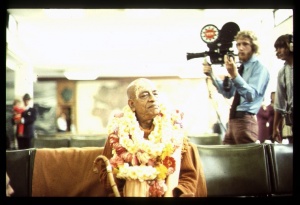SB 2.10.17: Difference between revisions
m (1 revision(s)) |
(Vanibot #0054 edit - transform synonyms into clickable links, which search similar occurrences) |
||
| (One intermediate revision by one other user not shown) | |||
| Line 1: | Line 1: | ||
{{info | {{info | ||
|speaker= | |speaker=Śukadeva Gosvāmī | ||
|listener=King | |listener=King Parīkṣit | ||
}} | }} | ||
[[Category:Srimad-Bhagavatam - Canto 02 Chapter 10]] | |||
[[Category:Bhagavatam Verses Spoken by Sukadeva Gosvami - Vanisource|021017]] | |||
<div style="float:left">'''[[Srimad-Bhagavatam]] - [[SB 2|Second Canto]] - [[SB 2.10: Bhagavatam Is the Answer to All Questions|Chapter 10: Bhagavatam Is the Answer to All Questions]]'''</div> | |||
<div style="float:right">[[File:Go-previous.png|link=SB 2.10.16]] '''[[SB 2.10.16]] - [[SB 2.10.18]]''' [[File:Go-next.png|link=SB 2.10.18]]</div> | |||
{{RandomImage}} | |||
==== TEXT 17 ==== | ==== TEXT 17 ==== | ||
<div | <div class="verse"> | ||
prāṇenākṣipatā kṣut tṛḍ | :prāṇenākṣipatā kṣut tṛḍ | ||
antarā jāyate vibhoḥ | :antarā jāyate vibhoḥ | ||
pipāsato jakṣataś ca | :pipāsato jakṣataś ca | ||
prāṅ mukhaṁ nirabhidyata | :prāṅ mukhaṁ nirabhidyata | ||
</div> | </div> | ||
| Line 16: | Line 22: | ||
==== SYNONYMS ==== | ==== SYNONYMS ==== | ||
<div | <div class="synonyms"> | ||
''[//vanipedia.org/wiki/Special:VaniSearch?s=prāṇena&tab=syno_o&ds=1 prāṇena]'' — by the living force; ''[//vanipedia.org/wiki/Special:VaniSearch?s=ākṣipatā&tab=syno_o&ds=1 ākṣipatā]'' — being agitated; ''[//vanipedia.org/wiki/Special:VaniSearch?s=kṣut&tab=syno_o&ds=1 kṣut]'' — hunger; ''[//vanipedia.org/wiki/Special:VaniSearch?s=tṛṭ&tab=syno_o&ds=1 tṛṭ]'' — thirst; ''[//vanipedia.org/wiki/Special:VaniSearch?s=antarā&tab=syno_o&ds=1 antarā]'' — from within; ''[//vanipedia.org/wiki/Special:VaniSearch?s=jāyate&tab=syno_o&ds=1 jāyate]'' — generates; ''[//vanipedia.org/wiki/Special:VaniSearch?s=vibhoḥ&tab=syno_o&ds=1 vibhoḥ]'' — of the Supreme; ''[//vanipedia.org/wiki/Special:VaniSearch?s=pipāsataḥ&tab=syno_o&ds=1 pipāsataḥ]'' — being desirous to quench the thirst; ''[//vanipedia.org/wiki/Special:VaniSearch?s=jakṣataḥ&tab=syno_o&ds=1 jakṣataḥ]'' — being desirous to eat; ''[//vanipedia.org/wiki/Special:VaniSearch?s=ca&tab=syno_o&ds=1 ca]'' — and; ''[//vanipedia.org/wiki/Special:VaniSearch?s=prāk&tab=syno_o&ds=1 prāk]'' — at first; ''[//vanipedia.org/wiki/Special:VaniSearch?s=mukham&tab=syno_o&ds=1 mukham]'' — the mouth; ''[//vanipedia.org/wiki/Special:VaniSearch?s=nirabhidyata&tab=syno_o&ds=1 nirabhidyata]'' — was opened. | |||
</div> | </div> | ||
| Line 23: | Line 29: | ||
==== TRANSLATION ==== | ==== TRANSLATION ==== | ||
<div | <div class="translation"> | ||
The living force, being agitated by the virāṭ-puruṣa, generated hunger and thirst, and when He desired to drink and eat, the mouth opened. | The living force, being agitated by the virāṭ-puruṣa, generated hunger and thirst, and when He desired to drink and eat, the mouth opened. | ||
</div> | </div> | ||
| Line 30: | Line 36: | ||
==== PURPORT ==== | ==== PURPORT ==== | ||
<div | <div class="purport"> | ||
The process by which all living beings in the womb of the mother develop their sense organs and sense perceptions appears to follow the same principles in the case of the virāṭ-puruṣa, the sum total of all living entities. Therefore the supreme cause of all generation is not impersonal or without desire. The desires for all kinds of sense perception and sense organs exist in the Supreme, and thus they take place in the individual persons. This desire is the nature of the supreme living being, the Absolute Truth. Because He has the sum total of all mouths, the individual living entities have mouths. Similarly with all other senses and sense organs. Here the mouth is the symbolic representation of all sense organs, for the same principles apply to the others also. | The process by which all living beings in the womb of the mother develop their sense organs and sense perceptions appears to follow the same principles in the case of the ''virāṭ-puruṣa'', the sum total of all living entities. Therefore the supreme cause of all generation is not impersonal or without desire. The desires for all kinds of sense perception and sense organs exist in the Supreme, and thus they take place in the individual persons. This desire is the nature of the supreme living being, the Absolute Truth. Because He has the sum total of all mouths, the individual living entities have mouths. Similarly with all other senses and sense organs. Here the mouth is the symbolic representation of all sense organs, for the same principles apply to the others also. | ||
</div> | </div> | ||
__NOTOC__ | |||
<div style="float:right; clear:both;">[[File:Go-previous.png|link=SB 2.10.16]] '''[[SB 2.10.16]] - [[SB 2.10.18]]''' [[File:Go-next.png|link=SB 2.10.18]]</div> | |||
__NOTOC__ | |||
__NOEDITSECTION__ | |||
Latest revision as of 21:12, 17 February 2024

A.C. Bhaktivedanta Swami Prabhupada
TEXT 17
- prāṇenākṣipatā kṣut tṛḍ
- antarā jāyate vibhoḥ
- pipāsato jakṣataś ca
- prāṅ mukhaṁ nirabhidyata
SYNONYMS
prāṇena — by the living force; ākṣipatā — being agitated; kṣut — hunger; tṛṭ — thirst; antarā — from within; jāyate — generates; vibhoḥ — of the Supreme; pipāsataḥ — being desirous to quench the thirst; jakṣataḥ — being desirous to eat; ca — and; prāk — at first; mukham — the mouth; nirabhidyata — was opened.
TRANSLATION
The living force, being agitated by the virāṭ-puruṣa, generated hunger and thirst, and when He desired to drink and eat, the mouth opened.
PURPORT
The process by which all living beings in the womb of the mother develop their sense organs and sense perceptions appears to follow the same principles in the case of the virāṭ-puruṣa, the sum total of all living entities. Therefore the supreme cause of all generation is not impersonal or without desire. The desires for all kinds of sense perception and sense organs exist in the Supreme, and thus they take place in the individual persons. This desire is the nature of the supreme living being, the Absolute Truth. Because He has the sum total of all mouths, the individual living entities have mouths. Similarly with all other senses and sense organs. Here the mouth is the symbolic representation of all sense organs, for the same principles apply to the others also.